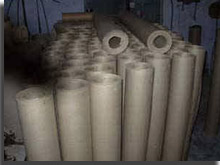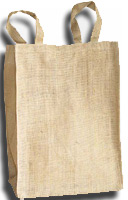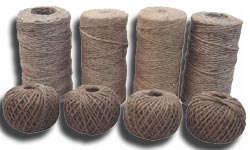| Size of the Industry | India today has around 78 jute mills |
| Geographical distribution | Jute mills are located in West Bengal, Andhra Pradesh, Assam, Odisha, Uttar Pradesh, Bihar, Tripura and Chhattisgarh |
| Output per annum | The Indian Jute Industry today accounts for a turnover of Rs 6,500 crore annually, contributing to exports to the tune of nearly Rs.1000 crore. |

In the year 1880, jute industry has acquired almost the whole of Dundee and Calcutta. Then later in 19th century, the manufacturing of jute has started in other countries also like in France, America, Italy, Austria, Russia, Belgium and Germany. Most of the Jute barons had started to quit India, leaving the set up of jute mills after Independence. Most of them were taken up by Marwaris businessmen.

The Indian Jute industry has been expanding really fast spanning from a wide range of life style consumer products, with courtesy to the versatility of Jute. Innovative ways of bleaching, dyeing and finished goods processes - the jute industry now provides finished jute products that are softer, have a lustre with aesthetic appeal. Today Jute has been defined as eco-friendly natural fiber with utmost versatility ranging from low value geo-textiles to high value carpets, decoratives, apparels, composites, upholstery furnishings, etc.

Government of India has included the Jute Production for special attention in its National Common Minimum Programme. For this mission, it has approved a sum of Rs.355.55 crore. And also in the year 2006-07 the approved allocations for Mini Mission -I and Mini Mission-II under the JTM for the remaining year of X Plan was at Rs.2.46 crore. The Ministry of Agriculture allocated 9.75 crore subject to the condition that the Department of Expenditure will find savings from the existing allocation of Ministry of Agriculture. The remaining year's allocations for Mini Mission-III and Mini Mission-IV of the X Plan at Rs.7.95 crore and Rs.30.85 crore respectively have been approved, which would be funded from the Plan savings of Ministry of Textiles
Import of jute and jute products
Period
2008- 2009
2007- 2008
2006- 2007
Qty.
Value
Qty.
Value
Qty.
Value
Raw Jute
59,042
8,900.31
1,71,800
19,672.39
94,363
15,031.15
Jute Products
70,935
20,299.48
57,688
13,809.41
60,932
17,162.87
Indian Exports of jute-diversified products (JDP) has gone up from Rs.93.4 crores in 1998-99 to Rs.257.3 crores in 2004-05, constituting 22 % of India's total jute goods export. Floor coverings and shopping bags together account for about 97 % of all lifestyle JDP exports. The U.S. is the biggest market for Indian JDP, followed by a few European countries such as the United Kingdom, Germany, Italy and Spain. The government aims to increase the exports of jute and jute products to nearly Rs.5,000 crores in the years to come.
- National Centre for Jute diversification, Kolkata
- Jute Manufacturers Development Council, Kolkata
- National Jute Manufacturers Corporation
- Jute Corporation of India Ltd., Kolkata
- Birds jute & Exports Ltd.
- Institute of Jute technology, Kolkata
- Indian Jute Industries Research Association, Kolkata
Jute mills are majorly located in West Bengal Andhra Pradesh, Assam, Odisha, Uttar Pradesh, Bihar, Tripura and Chhattisgarh. India has around 78 Jute Mills
For greater growth and development of the Jute Industr, Govt. of India launched National Jute policy in 2005 with the following objectives:
- Achieving a Compound Annual Growth Rate (CAGR) of 15% per annum.
- Improving the quality of jute fiber.
- Value addition through diversified jute products.
- Ensuring remunerative prices to the jute farmers.
- To enhance the yield per hectare from 2200 kg/hec. to 2700 kg/hec. in 2010-11.
 Recent Press Release
Recent Press Release
 INDIAN jute Industry AT A Glance IN 2021 - 2022
INDIAN jute Industry AT A Glance IN 2021 - 2022
 INDIAN jute Industry AT A Glance IN 2020 - 2021
INDIAN jute Industry AT A Glance IN 2020 - 2021
 INDIAN jute Industry AT A Glance IN 2018 - 2019
INDIAN jute Industry AT A Glance IN 2018 - 2019
 INDIAN jute Industry AT A Glance IN 2017 - 2018
INDIAN jute Industry AT A Glance IN 2017 - 2018
 INDIAN jute Industry AT A Glance IN 2016 - 2017
INDIAN jute Industry AT A Glance IN 2016 - 2017
 INDIAN jute Industry AT A Glance IN 2015 - 2016
INDIAN jute Industry AT A Glance IN 2015 - 2016
 INDIAN jute Industry AT A Glance IN 2013 - 2014
INDIAN jute Industry AT A Glance IN 2013 - 2014
 INDIAN jute Industry AT A Glance IN 2012 - 2013
INDIAN jute Industry AT A Glance IN 2012 - 2013
 INDIAN jute Industry AT A Glance IN 2011 - 2012
INDIAN jute Industry AT A Glance IN 2011 - 2012
Indian Industries


